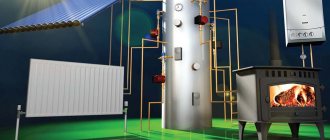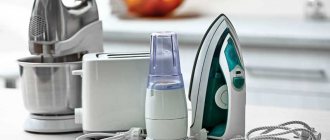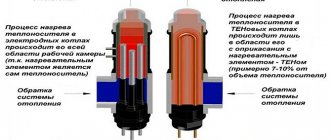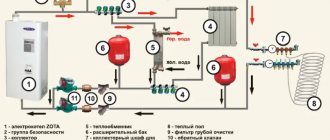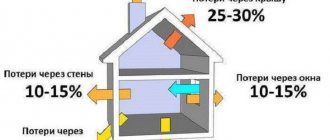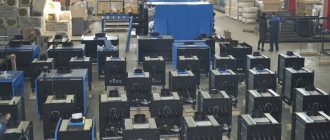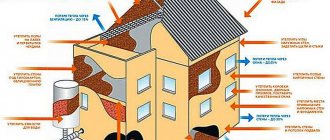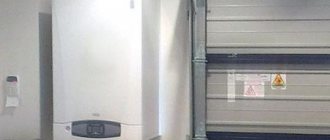The amount of electricity consumed by household appliances, lighting, heating, air conditioning and ventilation directly affects the amount of payment for electricity. Any equipment absorbs energy in the amount of the corresponding power of the device. This important characteristic is the basis for calculating electricity consumption. How to calculate the power consumption of electrical appliances and determine the electricity consumption are questions that are answered in this article.
Electricity consumer connection:
Origin of the unit of measurement kilowatt/hour
The intensive study of electricity by European scientists began around the 17th century, at which time fundamental discoveries were made that marked the beginning and development of such a science as electrical engineering. Scottish engineer, mechanical inventor (1736–1819) James Watt introduced into use the first unit of power - horsepower.
Portrait of James Watt:
In 1782, the British Association of Engineers assigned the scientist's name to the unit of power meter - Watt. It must be borne in mind that in Russian the English letter “W” has a double reading, like “V” or “Ua”. Therefore, we read the name of the inventor as Watt, and the unit of measurement is Watt. In 1889, the unit of measurement gained worldwide recognition. Only in 1960, “Watt” officially entered the international SI system as a power meter for any type of energy, be it thermal, mechanical or electrical.
The energy consumption consumed over a certain period of time is measured in W/h. To reduce the number of symbols when indicating the power consumption of an electrical appliance, a unit such as kilowatt/hour - kW/h (1000 Wh) was introduced into use.
Negative effects of reactive load
Learn to easily calculate the power consumption of an electrical appliance
The reactive load does not perform any useful work. Fluctuations in the reactive component from source to consumer only cause parasitic losses. In addition, industrial enterprises are required to pay for the reactive energy supplied to them. This is due to the fact that most energy receivers are electric motors and transformers. The amount of electricity consumed (kWh) does not all go to useful work, but you also need to pay for its reactive component.
Capacitor compensation units will help solve this problem. After all, if you connect a capacitive load in parallel with an inductive load, you can reduce the effect of parasitic currents to a minimum. Such installations are installed at substations supplying consumers.
Determination of power consumption
Calculating electricity consumption by power can be done in several ways. They are described below.
Nameplate data
Over time, a generally accepted practice has developed - to indicate the technical parameters of household appliances on nameplates. To find out the power consumption, just read the data on the plate.
Nameplates:
Calculation by formula
Knowing the voltage in the current source (household outlet, batteries or accumulator) and the current that the device consumes, there is nothing easier than determining the power consumption of an electrical device. In this case, the calculation formula will look like this:
N = VxI. Where N is power (W); V—voltage (V); I - current strength (A).
Multimeter:
For example, using a multimeter in ammeter mode, they find out the current strength for which the electric saw is designed - 8.2 amperes. Since the equipment operates from a household power supply of 220 volts, it will be quite simple to calculate the power consumption of the saw: 220 × 8.2 = 1800 W = 1.8 kW.
Circuit for measuring current with a multimeter:
Measurement with a wattmeter
This is a universal way to calculate electricity consumption using such a device. Currently, it is quite easy to purchase it online in one of the Chinese online stores.
Wattmeter:
Wattmeter is a power meter for various electrical consumers. The device determines the power characteristics of a device for any purpose operating from a household electrical network. On its back there is a plug that is inserted into the socket. In the front part of the case, under the display, there is its own socket. The equipment under test is connected to it.
Using this tester is one of the ways to calculate the electricity consumption of any household electrical appliance. The power meter is a kind of bridge that connects the consumer with the current source. They take measurements over a certain period of time. Then you can calculate how much money a refrigerator or washing machine “spends”. The tester has a built-in battery, which is needed to remember previously obtained readings and calculate the monetary costs for consumed electricity. In other words, a wattmeter can be characterized as an individual electric meter that serves one electrical appliance.
Elimination method
With this method, the electric meter acts as a power meter. Let’s say that there is electrical equipment in the house that does not have a nameplate, the documentation for it has long been lost or did not exist at all. There is the easiest way to calculate electricity consumption - this is the elimination method. Proceed as follows: de-energize all appliances in the apartment or house, turn off the lights, and turn the block toggle switches on the electric meter to the “Off” position. except one.
Taking electric meter readings:
The desired device is turned on for as long as possible. The amount of electricity consumed for 1 hour should be recorded. If circumstances do not allow this, then switching on is carried out within a time period that is a multiple of 60 minutes.
For example, if the equipment worked for 10 or 20 minutes, then the result is multiplied by 6 or 3 accordingly. If the device consumed 800 W within an hour, this means that its power is 0.8 kW/h. If you display the average number of operating hours of an electrical consumer per month, you can determine the costs that this equipment brings. To do this, the indicator is multiplied by the cost of 1 kW/h.
Power consumption calculator
You can use an online calculator as a power meter. One of its options can always be found on the Internet. The main purpose of the network service will help you determine the power of all electrical consumers located in a house, apartment or office. The results obtained are indicative in nature, but with their help you can calculate the electricity consumption of different types of consumers.
Using the calculator, homeowners can calculate future energy costs. Knowing the weak points in the overall picture of energy consumption, you can optimize the operating mode of the main electrical appliances. This can bring significant savings to the family budget.
The calculator is easy to use. The relevant data about lighting devices is entered into the interface windows - the power and number of lamps of different types, then information about electrical appliances is entered: a refrigerator, a TV, a washing machine and other household appliances, a computer, related office equipment and various power tools. After this, the current electricity tariff is entered into the “Cost of 1 kW” window. By clicking the “Calculate” button with the cursor, you get the estimated value of energy consumption for the month, as well as the amount to pay for electricity.
Informative way
There is a lot of information on the Internet about the capacities of various household appliances. Homeowners know and can compile a list of electricity consumers indicating their average power taken from the network. Residents can also count a certain number of operating hours of devices per day. From here the final result of electricity consumption for the month is obtained.
For power plants (this includes equipment with electric motors), a correction factor of k = 1.2 should be introduced, taking into account the sharp increase in starting power. The following table shows a standard list of household appliances. It may differ significantly from the list, which will include homestead equipment - these are machines, pumps, lawn mowers and much more.
Average power of household appliances:
After reading this article, it becomes clear what the power consumption of electrical appliances is and how it can be calculated. The accuracy of any calculation of electricity costs is verified by the bill of the local electricity company. If there is a significant discrepancy in the results, it is necessary to reconsider the methodology for calculating the power consumption of all electrical appliances. You need to know that all calculation methods will not be accurate, but they will be able to tell you where you can save energy.
Electrical appliance utilization (load) factor
Such uneven consumption is taken into account by a specialized parameter - the utilization (load) factor, defined as the ratio of actual power to nominal power. To take it into account in the calculation, it is enough to multiply the rated power of the power receiver by the specified coefficient.
The utilization rates for a number of household electrical appliances are shown in the table below.
| Energy receiving devices | Coefficient use |
| Lighting | 0,7 |
| TV | 0,7 |
| Consumer electronics | 0,2 |
| Fridge | 0,8 |
| Dishwasher | 0,1 |
| Washing machine | 0,1 |
| Iron | 0,1 |
| Vacuum cleaner | 0,1 |
| Boiler | 0,2 |
| Electric heater | 0,5 |
Formula for calculations
How to calculate electrical energy consumption
All data necessary to be substituted into the formula for calculations can either be measured or taken from the characteristics of the instruments used.
For your information. If the passport data indicates the value of cos ϕ, it means that the electricity received by the device will have a reactive component. This also needs to be taken into account when calculating.
The formula for calculation is:
P = I * U * cos ϕ,
Where:
- I – current in amperes;
- U – voltage in volts;
- cos ϕ – phase shift.
In the case of an active load, the phase shift is not substituted into the formula, and it has the form:
P = I * U.
Which devices really suck energy in standby mode?
Transformer chargers do waste electricity. But in everyday life, such power supplies are not often found and it is unlikely that anyone would think of leaving them in the outlet. What comes to mind is a charger for a car battery, a power supply for an LED strip, a power supply for a laptop and a charger for AAA batteries. Modern lightweight charging transformers do not have transformers in their design.
But the computer took 1.3 watts from the network when turned off, the 23″ monitor took 0.8 watts. The microwave in standby mode consumes as much as 1.6 watts for the glowing clock, which I still can’t set up (and after measuring it, I still unplugged it...).
We don’t keep televisions; devices with a remote control or a so-called “soft” start - they eat quite well. Plus these annoying LEDs are everywhere, which also need energy.
A multicooker in standby mode consumes 1.4 watts, a gas double-circuit boiler consumes 2 watts.
The electricity consumption in standby mode for the kettle, toaster and table lamp is zero, and I don’t see the point in checking the refrigerator, no matter how much you “eat” - you can’t get anywhere.
Why Circuit Reactance Affects AC Power
A sinusoidal voltage harmonic, entering a resistive resistance, changes the magnitude of the current without its deviation on the complex plane.
Such current performs useful work with minimal energy losses, generating active power. The frequency of the signal does not have any effect on it.
The resistance of the capacitor and inductance depends on the frequency of the harmonic. Its opposition deflects the direction of the current on each of these elements in different directions.
Such processes are associated with the loss of part of the energy for useless transformations. They consume power Q, which is called reactive. Its influence on the total power S and the connection with active P is conveniently represented graphically by a right triangle.
I wanted to draw it against the background of equipment made from piles of porcelain and metal, where I had to work for quite a long time. I got distracted. Don't judge harshly for this.
Compare it with the resistance triangle I published earlier. Do you find any common features?
They are the geometric proportions of the figure, the formulas describing them and the angle φ, which determines the total power loss. Let me move on to a more detailed consideration of them.
Features of calculation
To calculate power without having complete data on current and voltage consumption, you can use average characteristics. By consulting reference books, you can find out that lighting equipment can consume current up to 15 A. The maximum current of powerful devices reaches 50-60 A. The power factor, if it is not indicated or known, can be taken as 0.7 - this is the average value.
Single-phase voltage in a household network is 220 V. Its linear value in three-phase networks is 380 V.
Safety
Any electrical appliance is a source of danger, careless handling of which can lead to electrical injuries. In addition, equipment may break, exposing the user to the risk of electric shock.
Most stationary kitchen appliances must be connected to a three-wire electrical network, with one conductor connected to the ground loop. But what if the house is not equipped with it? But these are the majority in our country. The simplest solution is to install a residual current device (RCD), which will instantly disconnect the line when a leakage current is detected on it, thereby minimizing the risk of electric shock. To save space in the distribution panel, instead of a circuit breaker and RCD, you can use a differential circuit breaker. True, this solution is somewhat more expensive.
Source
A little history
Labeling the energy consumption class of a product has been used in Europe since the 90s of the 19th century. Now the label is used in more than 50 countries around the world. Mandatory energy efficiency labeling has become a key tool for efficient energy consumption and a driving force for reducing the energy intensity of the gross national product. In practice, there are now two energy efficiency labeling systems:
- The American Energy Guide model, which involves analyzing the energy consumption of similar products and selecting from them about 25% with the lowest energy consumption, which are assigned the Energy Guide brand
- The labeling model adopted in the EU countries, which involves dividing all products of the same type into seven classes, from A to G. The same designations apply in Russia. The division is made according to the ranges of quantitative indicators of energy efficiency throughout the entire range of characteristics from the most economical to the most energy-wasting
The main levers of influence of energy efficiency labeling on the energy intensity of the economy include:
- restrictions on the export of energy-intensive products (the import of products of classes F and G into the EU countries is prohibited, and temporary restrictions have been introduced on the middle classes D and F)
- linking energy efficiency with carbon dioxide emissions into the atmosphere, implying the inclusion of labeling in the system of sales of air emission quotas
- a system of fiscal measures to limit the production and sale of energy wasteful equipment
- state support for those enterprises that are focused on using energy-efficient goods in the production
- discounts for consumers choosing energy efficient technologies
- promotion of energy saving and respect for the environment
Explanation of energy efficiency labels
The higher the energy consumption class of the device, the more efficiently it will work, while economically consuming energy resources. Products with the letter A marked on the packaging have the lowest energy consumption; products of class G, on the contrary, are the least efficient to use.
The gradation of consumer properties of a product by energy consumption class consists of ten steps. The energy consumption class affects prices: as the class increases, the cost of the product also increases.
At the same time, if your household appliances do not reach the first letter of the alphabet, this does not mean that they are bad. Products of classes “B” and “C” are also considered economical, since they spend only 75% and 95% of the norm, which in any case is less than 100%.
The quality and energy efficiency of devices may be higher than A. Some models may be marked “A+”, “A++” or “A+++”, which means they are even more efficient in use. Energy saving classes such as E, F, G, due to wastefulness of electricity, are practically not found among the characteristics of modern products.
“A+” class equipment will spend up to 42% of electricity from the standard 100%, a product with o will spend up to 30% of electricity, and an “A+++” class model will spend up to 22%.
The color will also tell you about the energy consumption class: the highest energy efficiency class is indicated by the darkest green color, a burgundy shade will indicate very high energy consumption. The cooler the color, the better.
Taking readings from induction meters
Induction meters can be distinguished by a spinning wheel, which is located just below the frame with numbers. These numbers are the meter readings. The number of digits depends on the model.
How to take readings from an inductive and electronic electricity meter
How many numbers to write off
Typically, the induction meter display has 5, 6 or 7 digits. In most cases, the last digit, less often two, are separated by a comma, color, or differ in size. We do not take into account all numbers after the decimal point when taking readings. They show tenths and hundredths of a kilowatt and should not be taken into account
That is, we do not take into account all the numbers after the decimal point.
But it is worth remembering that there are counter models that do not have a comma. In this case, when taking readings, you must write off all the numbers. If you don’t do this, sooner or later you will have to pay the difference, and it usually turns out to be very large. So be careful.
If you are unsure whether your meter has a comma, write down the model, name and call the customer service of the organization that supplies electricity. Let them clarify how many numbers in your case need to be written off when taking readings. You can also call an inspector to your home or check this data with the electrician of the management company.
How to shoot
Immediately after installing the meter, you were given a certificate in which the initial numbers are indicated. When you come to take readings from the light meter, take a piece of paper and copy down the current readings there (without taking into account the numbers separated by a comma). You can also not rewrite the zeros that appear at the beginning - up to the first digit (see photo).
Example of induction meter readings
For further calculations, data for the previous month is required. In the first month of use, you take them from the installation report, and in the future you need to either keep receipts or keep an accounting log. Where and how they will be stored is your choice.
Some subscriber services work in such a way that you don’t even need to count anything, you just need to transfer data within a certain period of time. Their automated system will write it to your personal account (or the operator will do it), then make the charges independently and generate a receipt. All you have to do is pay the invoice. But even in this case, for control, you can calculate how much you should pay for electricity yourself. Of course, it is unlikely that computers will make a mistake (they think), but you never know...
How to count
To calculate the electricity on the meter yourself, subtract the one that was there before from the number you just wrote. You get the number of kilowatts consumed over the last period.
For example, consider the readings in the photo above. Let the previous ones be 4852, the current ones 5101 (we ignore the numbers after the decimal point). We calculate the electricity consumption: 5101 - 4852 = 249 kW. To find out how much you need to pay, you need to multiply the resulting number of kilowatts (in this case 249 kW) by the tariff. Get the amount you have to pay for the light.
If the counter stands for a long time, sooner or later it will “reset to zero” - zeros will appear in the first positions. How to calculate electricity consumption in this case? Everything is very simple. This time you will have to rewrite the readings with all zeros, and put a “1” in front of the first one. For example, you asked to take readings from the meter, but only the last digits are different from zero. Or, as in the photo below, it costs only one.
After zeroing, there may be a picture like this, or there may be two digits other than zero, or three...
You rewrite the value as is, with all zeros (but we don’t write numbers after the decimal point), put a unit in front of the first zero, and then count as before. Let's count the readings in the photo. We write off the reading, putting “1” in front: 100001. Let the last reading be 99863. Subtract 100001 - 99863 = 138 kW. Total consumption for the reporting period was 138 kW. In the future, you write off the electric meter readings as before, without leading zeros and without substituting a unit.
Calculation of electricity consumption
How to calculate electricity consumption, knowing the power of the device? It's easy to do this:
- If the device indicates a power range, for example, 400–500 W, then you need to take the average value - 450 W.
- Next, the average or exact power value must be multiplied by the number of hours during which the electrical appliance operates. For example, an air conditioner with a capacity of 2 kW per hour runs continuously for 8 hours a day. During the day it will consume 2 kW * 8 hours = 16 kW of electricity.
- To calculate the monthly operation of an air conditioner, you need to multiply the amount of electricity consumed per day by the device by the number of days in a month during which the device operates. If we take the daily operation of the air conditioner with 8-hour continuous operation, then for a month it will be: 16 * 30 = 480 kW.
- The knowledge gained must be multiplied by the cost of 1 kW/h. You can view this value on your electricity receipt.
Calculation of main electricity consumers
Every home uses a variety of household appliances - from electronic watches to dishwashers. They all consume electricity, and you need to be able to calculate the values for power from a single-phase or three-phase network. The total amount will depend on the standard and tariff established in the country.
Washing machine
This device belongs to powerful household appliances. Average power is 2000 W. At one time the machine works for about one and a half hours. Accordingly, 2000 × 1.5 = 3000 W of energy or 3 kW will be consumed per wash. This number is multiplied by the number of washes. For example, a person does 10 washes in a month - the machine will use 3*10=30 kW of electricity. When multiplied by the tariff, the cost that the owner must pay to the service provider is obtained.
Energy consumption will also be calculated depending on the weight of the laundry and the selected mode. The operating time of the device also depends on these indicators. A significant part of the energy is spent on heating water.
TV
As with a computer monitor, the power consumption of a TV depends on the size of the screen. The design of the device also has an impact. Old TVs powered by a cathode ray tube require 60-100 W, LCD models about 150-250 W, plasma models - 300-400 W.
Standby mode also requires energy. This is because there will be a red light on the screen, which also requires power. For devices based on a cathode ray tube, 2-3 W are required, for modern TVs 4-6 W.
Fridge
This is a device that works without interruption 24 hours a day, seven days a week. But depending on the time of year, the amount of electricity needed will vary. In winter, operation requires approximately 2 times less electricity than in summer.
Refrigerators are divided into classes based on energy consumption. Products with low energy consumption consume energy approximately equal to the volume of the device in liters. A device with a volume of 250 liters requires an average of 250 kW per year. The exact value can be found in the documentation for the refrigerator.
Kettle, iron, stove
An electric kettle requires on average 1.5-2.5 kWh of energy. The water heats up in about 4 minutes, i.e. this energy will be spent in 15 times. An iron consumes approximately the same power, but it depends on the operating mode. Maximum load required for initial heating. An electric stove is a powerful device; it requires approximately 3 kWh of energy to operate.
Microwave
The amount of electricity consumed depends on the volume, equipment, and operating modes. For quick heating, 0.9 kWh is required, for defrosting 0.2-0.4 kWh. The volume of food also affects power - a larger portion will require a greater load.
Warm floor
Electricity consumption for heated floors depends on the type and quality of thermal insulation, operating mode, room size, climatic conditions, type of coating and other important criteria. If the floor is the only and main source of heating, then about 0.2 kWh of energy will be spent per 1 square meter. To maintain a comfortable temperature in the room, 0.1-0.16 kWh of electricity will be consumed per 1 sq.m. To calculate the monthly costs for heated floors, you should multiply the consumption by 1 sq.m. on the area of the room, operating hours and number of days per month. For a more accurate determination, you can use a wattmeter. It is connected to an outlet and to an electrical receiver.
Video
Coffee capsule Nescafe Dolce Gusto Cappuccino, 3 packs of 16 capsules
1305 ₽ More details
Coffee capsules Nescafe Dolce Gusto Cappuccino, 8 servings (16 capsules)
435 ₽ More details
Bluetooth adapters
How to take meter readings correctly?
- Induction devices are “old-fashioned” bulky devices with a rotating wheel.
- Static - or modern electric.
Many people still have induction ones, but the trend towards switching to electronic models is already clearly visible - they calculate more accurately, look better, and do not make noise.
When taking readings from an induction device, pay attention to the first 5 digits (some models have 4). The last digit is usually placed slightly separately or highlighted in a different color, it rotates relatively quickly - it is, as a rule, not written on the receipt (for an even and simpler counting) - this is the reading after the “decimal point”
The last digit is usually placed slightly separately or highlighted in a different color, it rotates relatively quickly - it is usually not written on the receipt (for an even and simpler counting) - this is the reading after the “decimal point” in the decimal fraction.
It is better to take data on the same day of the month. In some regions of the country, it is customary to call the MES or RES on your own (on the appointed day) and report your readings.
Otherwise, the organization makes calculations based on average consumption over the past months - this data will be reflected in the receipt.
How to take readings from an electronic meter, multi-tariff readings
The electronic device can calculate a single tariff, or can be configured to count for several tariffs (different tariffs are introduced for the purpose of saving - during the day they are a little more expensive than usual, and at night they are much cheaper).
The desired mode is selected in the device menu (modes are usually changed by repeatedly pressing the enter button):
- T1 – for single tariff.
- T2 – for separate payment of the grace period from 23:00 to 7:00 am.
- T3 – one standard tariff and two preferential ones.
When these modes (T1 and T2) are displayed alternately, the device will show different readings that have accumulated over the month at a given tariff.
The difference with previous readings is calculated for each tariff separately.
